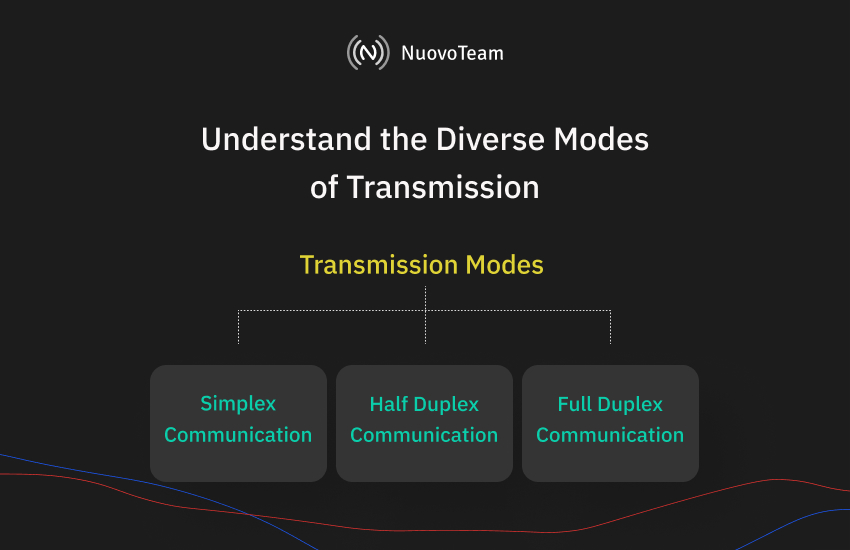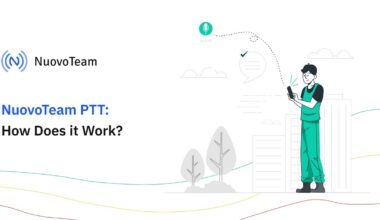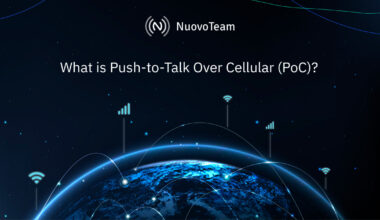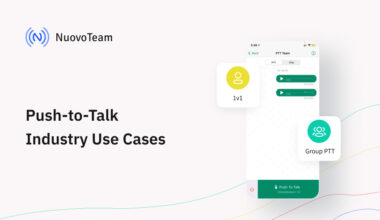We live in a hyper-connected world where communication is the key to business success. From hand-written letters to emails, from phone calls to video conferencing and from walkie-talkies to cellular push-to-talk apps, communication has greatly evolved to facilitate instant global connectivity. As more and more businesses rely on mobile devices to keep their field workforce connected, push-to-talk apps are gaining popularity.
If you have worked in the field, or if your business has a field workforce then you must already be familiar with the term push-to-talk. It is a half-duplex communication mode that is used by devices such as walkie-talkies and land mobile radios. But what does half-duplex mean? If walkie-talkies work on a half-duplex mode of communication, then does a full duplex exist too? Let’s understand the various modes of communication.
What is Simplex Communication?
Simplex communication is a uni-directional mode of communication in which two devices are connected, but only the sender can transmit messages and the receiving end can simply listen. This mode of communication creates a one-way channel for information transmission.
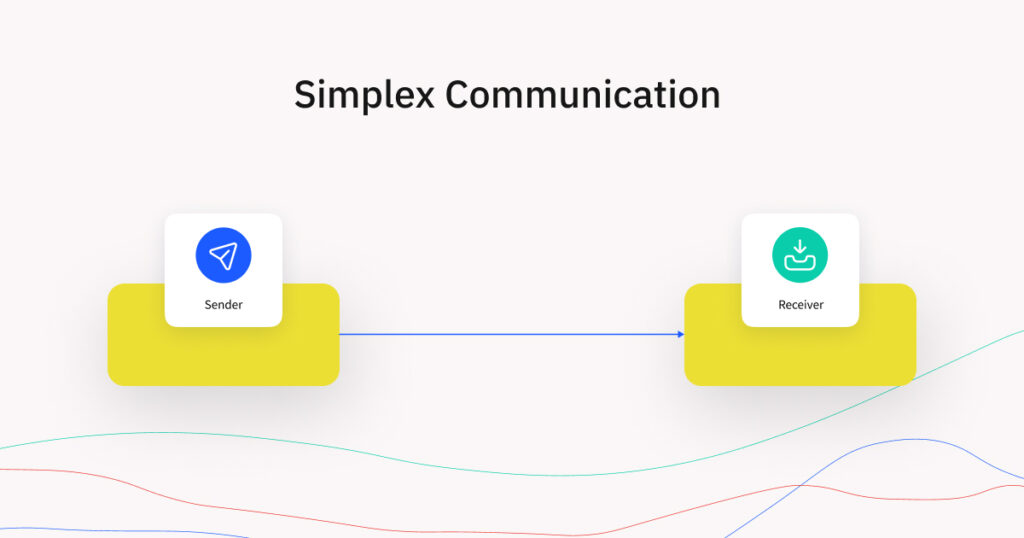
Advantages of simplex communication:
- It is a one-way transmission and utilizes the full capacity of the communication medium.
- Enables greater data transmission at a time since the entire bandwidth is utilized.
Disadvantages of simplex communication:
- Presents only unidirectional communication.
- No inter-communication between devices.
- Cannot be widely used for modern-day communication.
What is Half Duplex Communication?
Half-duplex communication is when two devices are connected, and both the sender and the receiver can communicate, but not simultaneously. It is a bi-directional mode of communication in which the sender and receiver can transmit voice messages one at a time.
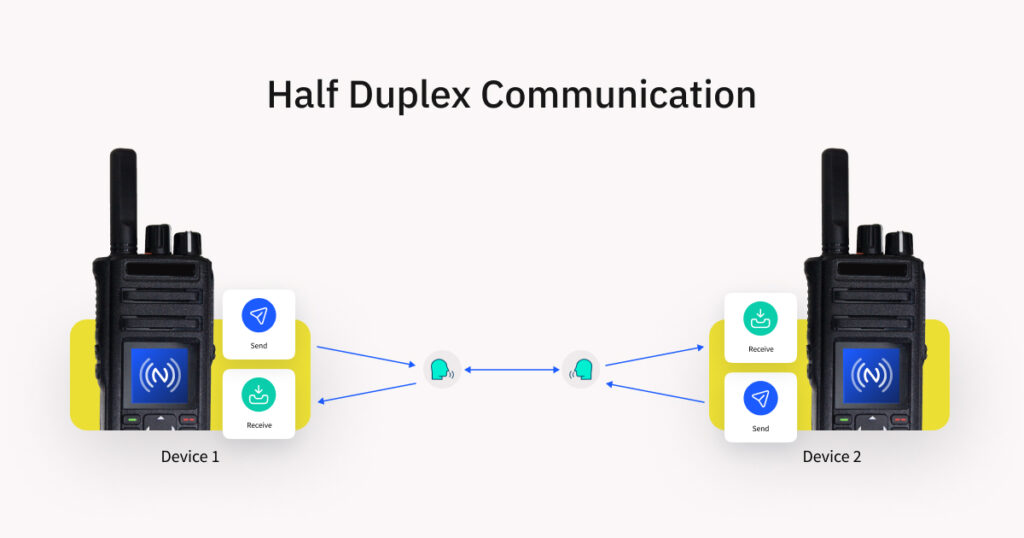
Advantages of half-duplex communication:
- It is easy to implement.
- No hardware complications.
- Offers time-saving communication.
- Can be leveraged over cellular and radio networks.
Disadvantages of half-duplex communication:
- Lower speed and performance in comparison to the full-duplex method.
What is Full Duplex Communication?
Full-duplex communication is a bi-directional mode of communication in which both the sender and the receiver can communicate simultaneously. Unlike half-duplex communication, full-duplex communication can establish a continuous two-way connection. Many modern Cloud Communication Platforms leverage full-duplex communication to enable seamless real-time interactions between users.
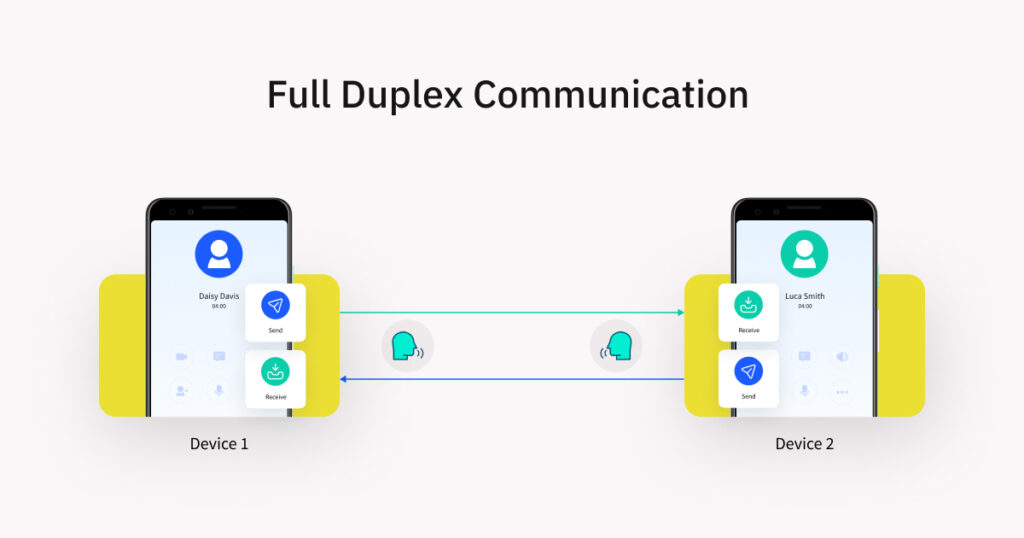
Advantages of full-duplex communication:
- High performance in comparison to half-duplex communication is particularly noticeable in intranet environments where simultaneous communication is crucial. This is especially useful when integrated with efficient intranet software solutions.
- Faster speed of transmitting and receiving the data.
- It doubles the utilization of the bandwidth.
- Best suited for modern-day office communication.
Disadvantages of full-duplex communication:
- Not all network equipment supports a full-duplex system.
- Connectivity may be time-consuming in comparison to half-duplex communication.
- Sometimes causes difficulty for the administrators to diagnose the issue in the network due to instability.
Difference Between Simplex, Half Duplex, and Full Duplex Modes of Transmission:
Parameter | Simplex Communication | Half-Duplex Communication | Full-Duplex Communication |
|---|---|---|---|
| Direction of communication | It is one-way communication in which only the sender transmits the message and the receiving end hears the message. | It is two-way communication in which both the sender and the receiver can transmit messages, but one at a time. | It is two-way communication in which both the sender and the receiver can transmit messages simultaneously. |
| Sender & Receiver | The sender can only send the data but not receive it. | Both sender and receiver can send and receive the data. | Both sender and receiver can send and receive the data. |
| Bandwidth | Simplex communication makes full use of a single bandwidth. | Half-duplex communication makes lesser use of a single bandwidth in comparison to full-duplex mode. | Full-duplex communication doubles the use of transmission bandwidth. |
| Performance | Yields a lower performance compared to half and full-duplex modes. | Yields a lower performance when compared to the full-duplex mode of communication | Yields the maximum performance as it makes use of double the bandwidth. |
| Examples | Televisions, radios, monitors, keyboards and microphones connected to speakers. | Walkie-talkies, two-way radios, land mobile radios. | Cellphones, telephone lines. |
| Industry Use-Cases | Emergency services, security services, healthcare, education, retail. | Construction, Logistics, Retail, Warehousing, Mining, Security services, Emergency services. | All industries. |
Why Is Half-Duplex Communication Ideal for a Field Workforce?
While most of the corporate world enjoys the benefits of full-duplex communication, some industries with a field workforce find cellular phone calls cumbersome and futile. Industries such as construction, warehousing, logistics and transportation, etc. have a field workforce that operates from remote, high-risk environments where speedy communication is critical. Pairing half-duplex communication with a knowledge base builder ensures that teams have both instant verbal updates and centralized access to important documents or protocols. Two-way radios such as walkie-talkies leverage half-duplex communication to offer instant push-button connectivity.
The field workforce functions in hazardous locations and operates heavy equipment. Here are some reasons why half-duplex communication outstands full-duplex communication for field employees:
- Hands-free communication
- Quick press-button connectivity
- No fuss of dialing numbers and typing long messages
- Straightforward and no-frills communication
Also read: How Does the NuovoTeam Push-to-Talk App Solve Field Service Communication Challenges?
Leveraging Half-Duplex Communication With NuovoTeam Push-to-Talk
What if we told you that there is a way that you can leverage the benefits of half-duplex communication straight from your smartphone? NuovoTeam is a Push-to-Talk (PTT) app that allows your smartphone to mimic the functionality of a half-duplex walkie-talkie device. Field workforce and leverage instant communication without the need to carry around extra radio communication devices.
Here’s why NuovoTeam PTT is the ideal solution to streamline your field communication:
- Highly compatible: NuovoTeam can be easily installed on Android, iOS smartphones, rugged smartphones and custom-built devices.
- Push-Button Connectivity: Users can leverage clear and stable push-button connectivity over cellular networks.
- Desktop PTT: PTT calls can be leveraged from any machine that has a Chrome browser to keep the office staff connected with the field workforce.
- SOS Communication Channel: Employees can initiate an SOS alert that includes a 10-second PTT message followed by auto-sharing of the employee’s current location.
- Group Communication: You can create public and private channels to make group PTT calls.
- Location Tracking: Field employees can be tracked easily with location monitoring capabilities.
- Live Voice Playback: You can replay previous PTT messages to revisit critical conversations.
- Multi-Media Messaging: You can send text messages, images, videos or files in diverse formats
Read more: 6 Things You May Not Know About Modern-Day Push-to-Talk
Closing Lines
While simplex communication may be the best choice where a response is not critical, full-duplex communication is largely preferred for modern-day corporate communications. However, with the growing number of field services, half-duplex communication is regaining its limelight. When critical factors such as productivity, operational efficiency, customer satisfaction and business growth are dependent on effective communication, enterprises must carefully pick what works best for them.
Explore seamless half-duplex communication designed for the modern-day field workforce with NuovoTeam.
